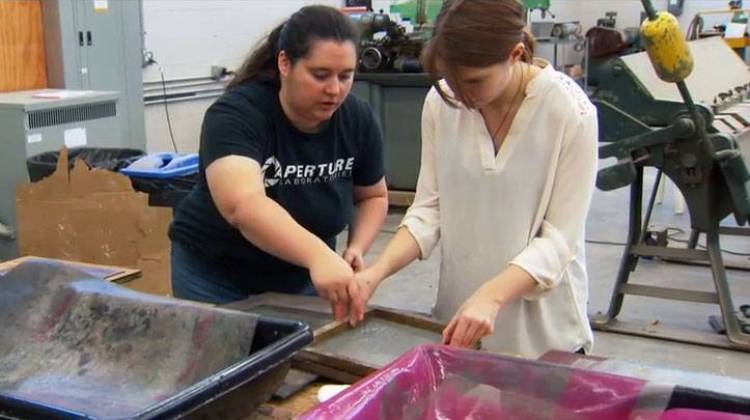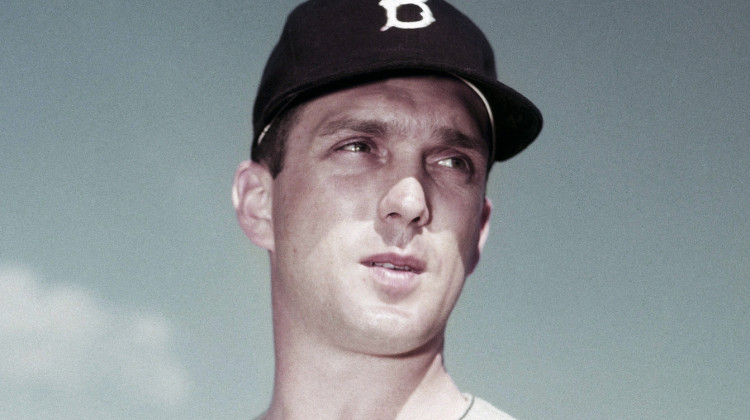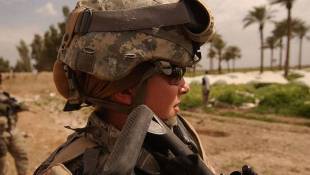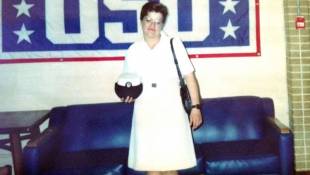
Veteran and Herron School of Art student Shanna Reis, left, helps a fellow Combat Paper workshop participant.
Veterans and members of the community recently gathered at Herron School of Art and Design for Combat Paper workshops. One of the veteran participants, Shanna Reis, appreciates using something old to make something new.
With a duffle bag of uniforms taking up space - but not something she could part with, Reis, an Indiana National Guard Army veteran, enjoys being able to transform her old uniforms into something she can put to a new use - paper. During a Combat Paper workshop last year at Herron she made the cover for a journal.
“I’m planning for this workshop to just pull blank sheets of paper and actually use the paper itself as the pages of the book. I write poems as well – so I’m looking to printing a book of poems using that paper.”
Veterans share stories as they deconstruct their uniforms, cut them into tiny squares which then get pulverized and made into pulp and then paper. Reis signed up for the National Guard in high school in 2000 and served for 12 years. She is now a sculpture major at Herron.
“I really like building big solid things with my hands- but at the same time, workshops like this and the book art classes through Herron kinda make me think, well, sometimes the smaller things are just as worthwhile.
In 2011, as an anthropology major at IUPUI, Reis struggled with her studies as she also struggled with issues related to her combat service.
Reis had been with the 76th Infantry Brigade and was deployed twice overseas - first in 2004.
“In Afghanistan, I was tapped to be a radio operator. I sat at the headquarters and monitored a bunch of radios and took down reports and just helped with the headquarters running.”
After nearly a year, Reis couldn’t wait to get home. She took a pass on mental health services the military provides to all returning soldiers. And at first, everything was fine.
“It was kinda like a slow creep where I felt something was wrong and it just got worse and worse and worse. I became very paranoid. I didn’t have nightmares like most people think I did but that was because I wasn’t sleeping. ‘Cause I was convinced that as soon as I closed my eyes something was going to happen. And then that kind of led to sleeplessness and I started getting audio hallucinations of events that happened. And it just kind building and building into more paranoia.”
11 percent of veterans coming home from Afghanistan and 20 percent from Iraq suffer PTSD. Many veterans don’t reach out for help and Reis was one of them.
“I kind of retreated into my room that I had with my mother at the time. And I just stayed there in like this little cave that I made. And I did not come out. I did not interact. I stopped working. I stopped doing things. And I slowly got better. But it was slow and a very nightmare-ish process for me. I did not at any time reach out for help at all. I dealt with it myself.”
In 2008 she was deployed as a military police officer to Iraq for 9 months. She knew she didn’t want to be in that hell again.
“That scared me more than anything else was trying to tough it out myself. So, this time – the out-processing was even longer. They took each individual soldier and sat us down in front of a medical officer who said, “There’s help available. Do you think you will need it?” And I straight up said Yes. I am gonna need it. I’m gonna need help.”
Today Reis encourages other veterans to reach out.
“ ‘Cause that’s the hardest part of it – is just the talking out loud. Not only so someone else hears it –but so that You hear it. And that was the thing that seemed to help me the most. It kind of forced me to sit there and process everything.”
The need to fill 3 credit hours back in 2011 that changed the course of Reis’ degree path. She signed up for charcoal drawing and found that just being in the building at Herron helped her relax. Today, she is one class shy of finishing her degree in sculpture.
 DONATE
DONATE






 View More Programs
View More Programs





 Support WFYI. We can't do it without you.
Support WFYI. We can't do it without you.